Lower back Pain is one of the most common complaints in the modern working class. Yoga management of lower back pain can be both preventive and curative. Most of us suffer from lower back pain at some point of life. Yoga management of lower back pain can be understood by first looking at the causes of back pain.
How does yoga help the lower back? Most of us today have a busy life style which involves sitting in one position for long period of time. In the office we sit on a chair for long hours. When we are home we spend time on the internet for long. Even for entertainment, we stare at the television for hours together. A long weekend trip involves driving for considerable period of time. It is very easy to understand why we end up giving constant stress to the lower back muscles during our work and as well as during leisure. Most of the brunt of our sedentary as well as busy life style is borne by the lower back muscles. No doubt, it becomes one of the most stressed out muscles in our body.
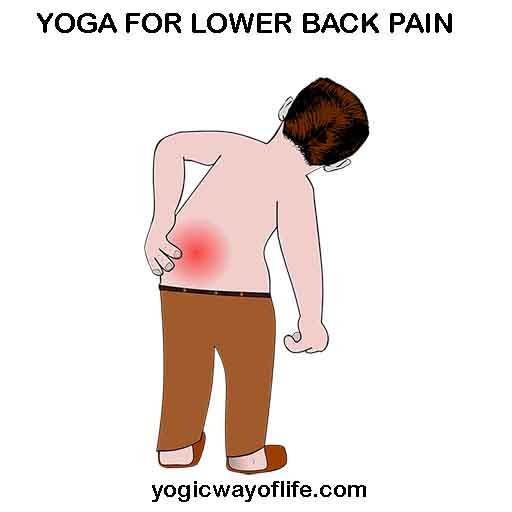
Yoga management of lower back pain is based on two principles. First of all, one should relax the back muscles to relieve the stress. Secondly, one needs to strengthen the back muscles to make it less susceptible to stress and subsequent pain.
At this stage, we would like to give a word of caution. Sometimes, the lower back pain may be caused by structural defects of the spine like disk prolapse, spine injuries, etc. In such cases, always consult a doctor for medical intervention. Perform yoga only with the consent of your physician. But in most cases, the lower back pain is caused by the regular stress and strain on the back muscles and it can be remedied by spending few minutes every day, with relaxation and stretching yogic exercises.
Yoga Relaxation Poses for Lower Back Pain
How many times we notice that after a stressful day at work, we come home and jump on to the couch and turn the television on. We do this to relax our mind and give it a pleasant diversion. But this does not give any relief to our lower back as we are again sitting for long hours, just as we were doing at work. So, what is the solution? It is simple. Just spend 5 minutes in any of the yogic relaxation poses. These yogic relaxation poses can be done a yoga mat or even on your bed.
- Shavasana: The most relaxing pose is the Shavasana or the yogic corpse pose.
 It is the simplest of all poses. After you return from a stressful day’ work, just lie down on the bed with legs slightly apart. Keep the hands stretched out with palms facing upwards on the side. Breathe from your belly in a slow and rhythmic manner. Keep the eyes closed and feel the relaxation. Do this for 5 minutes and you will feel rejuvenated.
It is the simplest of all poses. After you return from a stressful day’ work, just lie down on the bed with legs slightly apart. Keep the hands stretched out with palms facing upwards on the side. Breathe from your belly in a slow and rhythmic manner. Keep the eyes closed and feel the relaxation. Do this for 5 minutes and you will feel rejuvenated. - Advasana or the reverse corpse pose: This pose is equally rejuvenating as the corpse pose.
 This also helps those who suffer from upper back and shoulder pain. In this pose, one lies on the belly with hands stressed forward over the head. Close your eyes and breathe normally. Concentrate on the feeling of relaxation.
This also helps those who suffer from upper back and shoulder pain. In this pose, one lies on the belly with hands stressed forward over the head. Close your eyes and breathe normally. Concentrate on the feeling of relaxation. - Makarasana or the crocodile pose: Lie on your belly on the bed or the yoga mat.
 Raise the head and trunk and rest your head on your palms. The weight of the head should be borne by the elbows. Close your eyes and breathe normally for few minutes. This not only gives relaxation to the back, but also gives it a slight stretch to strengthen your back muscles.
Raise the head and trunk and rest your head on your palms. The weight of the head should be borne by the elbows. Close your eyes and breathe normally for few minutes. This not only gives relaxation to the back, but also gives it a slight stretch to strengthen your back muscles.
Yoga Poses for strengthening lower back muscles
- Marjariasana or the cat pose: The cat family has one of the most flexible spines in the animal kingdom.
 Marjariasana or the cat pose imitates a cat stretching its back. Assume a kneeling position with both hands (palms) touching the floor. The entire body weight is supported by the hands and the knees. Gently arch the back and spine, upwards and downwards, just like a cat doing a gentle stretch. Marjariasana stretches and strengthens the back muscles.
Marjariasana or the cat pose imitates a cat stretching its back. Assume a kneeling position with both hands (palms) touching the floor. The entire body weight is supported by the hands and the knees. Gently arch the back and spine, upwards and downwards, just like a cat doing a gentle stretch. Marjariasana stretches and strengthens the back muscles. - Bhujangasana or the cobra pose: lie down on the belly with hands on the sides.
 Now, slide the hands forwards (towards the shoulders) with the palms touching the floor. Gently raise your trunk upwards with the head and neck arched forward. The final pose looks like a cobra raising its hood. Remain in this pose for as long as you are comfortable and then release the pose by coming back to supine position.
Now, slide the hands forwards (towards the shoulders) with the palms touching the floor. Gently raise your trunk upwards with the head and neck arched forward. The final pose looks like a cobra raising its hood. Remain in this pose for as long as you are comfortable and then release the pose by coming back to supine position. - Ardha-Matsyendrasana or the half spinal twist pose: Sit with legs stretched out.
 Bend the right leg and place it to the left of the left leg. Now bend the left leg so that the heels touch the right buttocks. Take the left arm around the right leg and grab the toes of the right leg with the left hand. This may be difficult initially, but with practice the spine becomes flexible enough to do the half twist. Repeat with the other leg and twisting in the opposite direction. Ardha-Matsyendrasana makes the back flexible and strong.
Bend the right leg and place it to the left of the left leg. Now bend the left leg so that the heels touch the right buttocks. Take the left arm around the right leg and grab the toes of the right leg with the left hand. This may be difficult initially, but with practice the spine becomes flexible enough to do the half twist. Repeat with the other leg and twisting in the opposite direction. Ardha-Matsyendrasana makes the back flexible and strong. - Shashakasana or the Hare pose: Sit in the kneeling position.
 Raise the hands above the head. Slowly breathe out and bend over to touch the forehead to the ground. The hands will remain stretched touching the floor. Shashankasana relaxes the back muscles and also relives sciatic pain.
Raise the hands above the head. Slowly breathe out and bend over to touch the forehead to the ground. The hands will remain stretched touching the floor. Shashankasana relaxes the back muscles and also relives sciatic pain.
Apart from these yoga asanas, there are many backward bending poses which can strengthen the back muscles. They should be taken up after practicing the simpler poses mentioned above. Chakrasana, Ardha Chakrasana, Dhanurasana and Ushtrasana are some of the backward bending asanas for strengthening the back, neck and shoulders.
Hence we see that yoga management of lower back pain is based on muscle relaxation and muscle strengthening exercises. If one tries to strengthen a stiff muscle, it may be counter-productive. Therefore, the first step is always relaxation and then followed by strengthening of the back muscles.

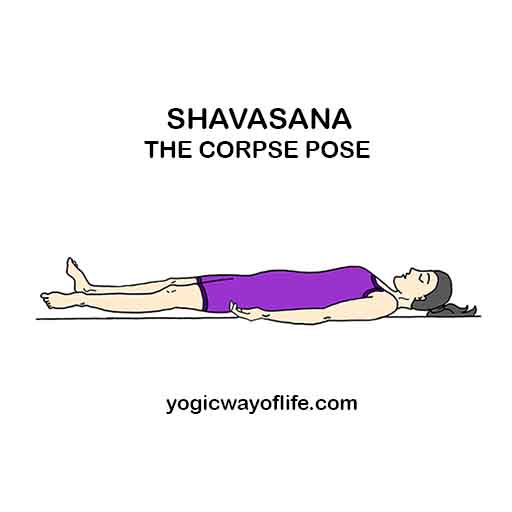 It is the simplest of all poses. After you return from a stressful day’ work, just lie down on the bed with legs slightly apart. Keep the hands stretched out with palms facing upwards on the side. Breathe from your belly in a slow and rhythmic manner. Keep the eyes closed and feel the relaxation. Do this for 5 minutes and you will feel rejuvenated.
It is the simplest of all poses. After you return from a stressful day’ work, just lie down on the bed with legs slightly apart. Keep the hands stretched out with palms facing upwards on the side. Breathe from your belly in a slow and rhythmic manner. Keep the eyes closed and feel the relaxation. Do this for 5 minutes and you will feel rejuvenated.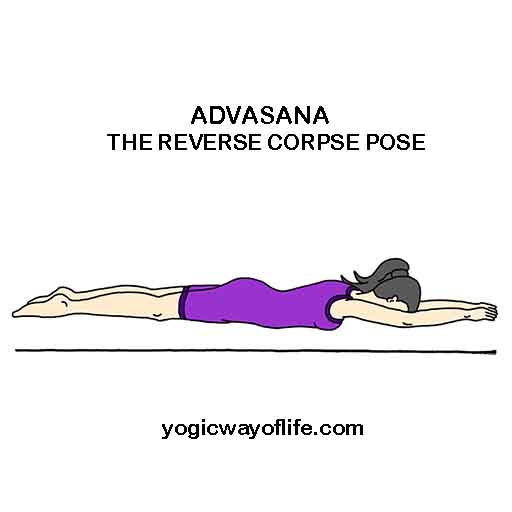 This also helps those who suffer from upper back and shoulder pain. In this pose, one lies on the belly with hands stressed forward over the head. Close your eyes and breathe normally. Concentrate on the feeling of relaxation.
This also helps those who suffer from upper back and shoulder pain. In this pose, one lies on the belly with hands stressed forward over the head. Close your eyes and breathe normally. Concentrate on the feeling of relaxation.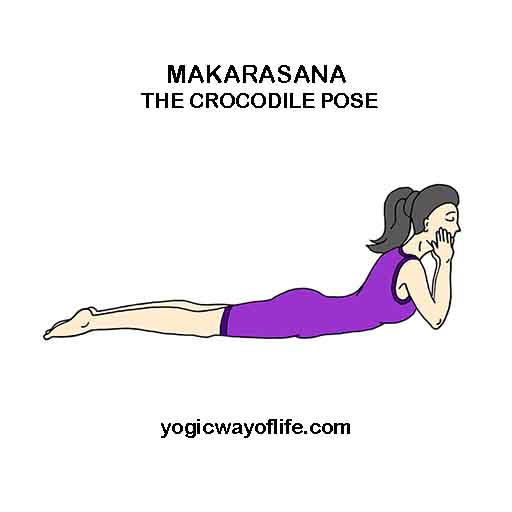 Raise the head and trunk and rest your head on your palms. The weight of the head should be borne by the elbows. Close your eyes and breathe normally for few minutes. This not only gives relaxation to the back, but also gives it a slight stretch to strengthen your back muscles.
Raise the head and trunk and rest your head on your palms. The weight of the head should be borne by the elbows. Close your eyes and breathe normally for few minutes. This not only gives relaxation to the back, but also gives it a slight stretch to strengthen your back muscles.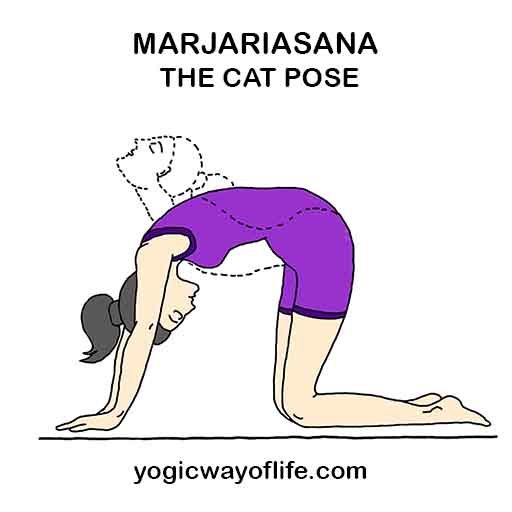 Marjariasana or the cat pose imitates a cat stretching its back. Assume a kneeling position with both hands (palms) touching the floor. The entire body weight is supported by the hands and the knees. Gently arch the back and spine, upwards and downwards, just like a cat doing a gentle stretch. Marjariasana stretches and strengthens the back muscles.
Marjariasana or the cat pose imitates a cat stretching its back. Assume a kneeling position with both hands (palms) touching the floor. The entire body weight is supported by the hands and the knees. Gently arch the back and spine, upwards and downwards, just like a cat doing a gentle stretch. Marjariasana stretches and strengthens the back muscles.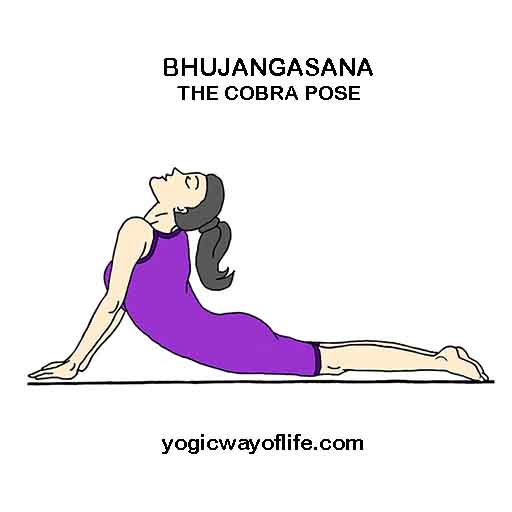 Now, slide the hands forwards (towards the shoulders) with the palms touching the floor. Gently raise your trunk upwards with the head and neck arched forward. The final pose looks like a cobra raising its hood. Remain in this pose for as long as you are comfortable and then release the pose by coming back to supine position.
Now, slide the hands forwards (towards the shoulders) with the palms touching the floor. Gently raise your trunk upwards with the head and neck arched forward. The final pose looks like a cobra raising its hood. Remain in this pose for as long as you are comfortable and then release the pose by coming back to supine position.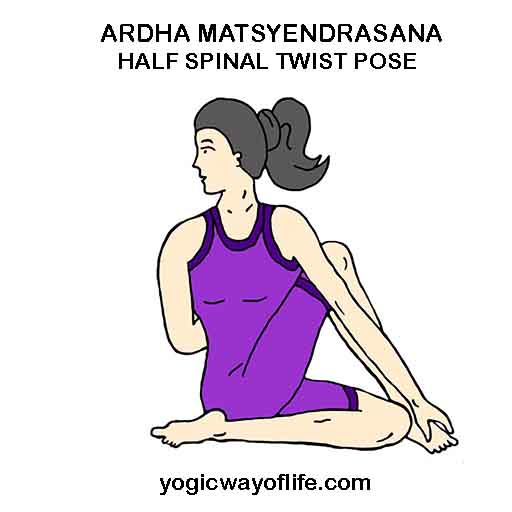 Bend the right leg and place it to the left of the left leg. Now bend the left leg so that the heels touch the right buttocks. Take the left arm around the right leg and grab the toes of the right leg with the left hand. This may be difficult initially, but with practice the spine becomes flexible enough to do the half twist. Repeat with the other leg and twisting in the opposite direction. Ardha-Matsyendrasana makes the back flexible and strong.
Bend the right leg and place it to the left of the left leg. Now bend the left leg so that the heels touch the right buttocks. Take the left arm around the right leg and grab the toes of the right leg with the left hand. This may be difficult initially, but with practice the spine becomes flexible enough to do the half twist. Repeat with the other leg and twisting in the opposite direction. Ardha-Matsyendrasana makes the back flexible and strong.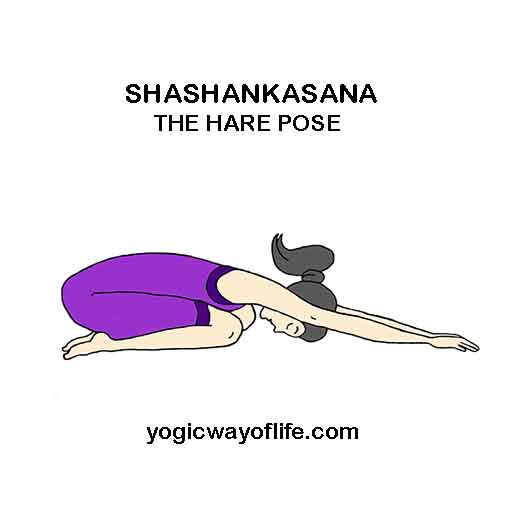 Raise the hands above the head. Slowly breathe out and bend over to touch the forehead to the ground. The hands will remain stretched touching the floor. Shashankasana relaxes the back muscles and also relives sciatic pain.
Raise the hands above the head. Slowly breathe out and bend over to touch the forehead to the ground. The hands will remain stretched touching the floor. Shashankasana relaxes the back muscles and also relives sciatic pain.
Excellent article. I have relief doing the asanas for my lower back ache.